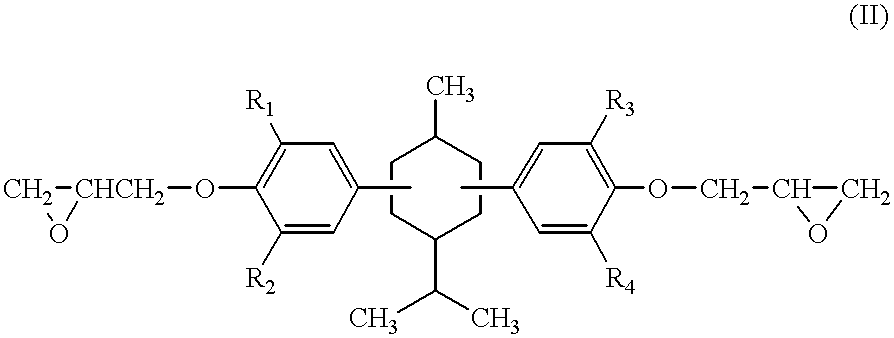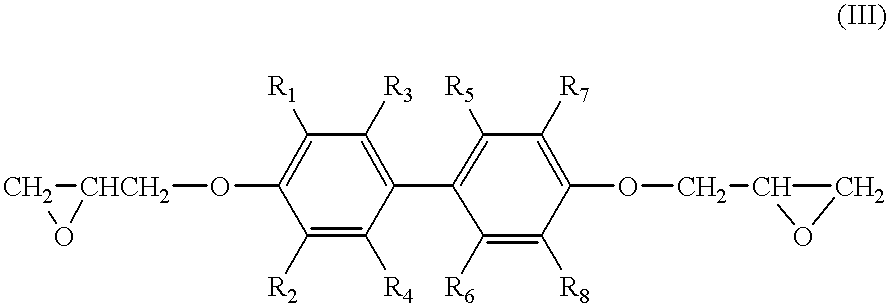Adhesive sheet for semiconductor connecting substrate, adhesive-backed tape for tab, adhesive-backed tape for wire-bonding connection, semiconductor connecting substrate, and semiconductor device
- Summary
- Abstract
- Description
- Claims
- Application Information
AI Technical Summary
Problems solved by technology
Method used
Image
Examples
reference example 2
(preparation of a soluble content of a high molecular resol phenol)
A high molecular resol phenol (Bell Pearl S895 produced by Kanebo, Ltd.) was dissolved into chlorobenzene at 60.degree. C. to achieve a concentration of about 10 wt %. The solution was filtered by a 0.5 .mu.m filter, and the soluble content was taken out. From the difference in solid concentration before and after filtration, the obtained soluble content was 96%.
example 1
Aluminum hydroxide (H-421 produced by Showa Denko K.K.) was mixed with toluene, and the mixture was treated by a sand mill, to prepare an aluminum hydroxide dispersion. NBR-C (PNR-1LH produced by Japan Synthetic Rubber Co., Ltd.), bisphenol A type epoxy resin ("Epikote" 834 produced by Yuka Shell Epoxy K.K., 250 in epoxy equivalent), brominated epoxy resin ("Epikote" 5050 produced by Yuka Shell Epoxy K.K., 49% in bromine content and 395 in epoxy equivalent), 4,4'-diaminodiphenylsulfone and methyl ethyl ketone equal in weight to the dispersion were added to the dispersion to achieve the composition ratio shown in Table 2, and the mixture was stirred at 30.degree. C., to prepare an adhesive solution. The adhesive solution was applied to a 25 .mu. thick polyethylene terephthalate film with a silicone releasing agent ("Film Bina" GT produced by Fujimori Kogyo Co., Ltd.) by a bar coater to achieve a dry thickness of about 50 .mu., and dried at 170.degree. C. for 5 minutes. Two sheets of ...
example 2
Spherical silica ("Ecserica" produced by Tokuyama Corp.) was mixed with toluene, and the mixture was treated by a sand mill, to prepare a dispersion. NBR-C (PNR-1H produced by Japan Synthetic Rubber Co., Ltd.), SEBS-C (MX-073 produced by Asahi Chemical Industry Co., Ltd.), naphthalene skeleton-containing epoxy resin ("Epiclon" HP4032 produced by Danippon Ink & Chemicals, Inc., 150 in epoxy equivalent), 4,4'-diaminodiphenylsulfone, and methyl ethyl ketone equal in weight to the dispersion were added to the dispersion to achieve the composition ratio shown in Table 1, and the mixture was stirred at 30.degree. C. to prepare an adhesive solution. The adhesive solution was used to obtain a pure copper sheet with an adhesive layer as described in EXAMPLE 1. The properties are shown in Table 3.
PUM
| Property | Measurement | Unit |
|---|---|---|
| Temperature | aaaaa | aaaaa |
| Temperature | aaaaa | aaaaa |
| Temperature | aaaaa | aaaaa |
Abstract
Description
Claims
Application Information
 Login to View More
Login to View More - R&D
- Intellectual Property
- Life Sciences
- Materials
- Tech Scout
- Unparalleled Data Quality
- Higher Quality Content
- 60% Fewer Hallucinations
Browse by: Latest US Patents, China's latest patents, Technical Efficacy Thesaurus, Application Domain, Technology Topic, Popular Technical Reports.
© 2025 PatSnap. All rights reserved.Legal|Privacy policy|Modern Slavery Act Transparency Statement|Sitemap|About US| Contact US: help@patsnap.com



